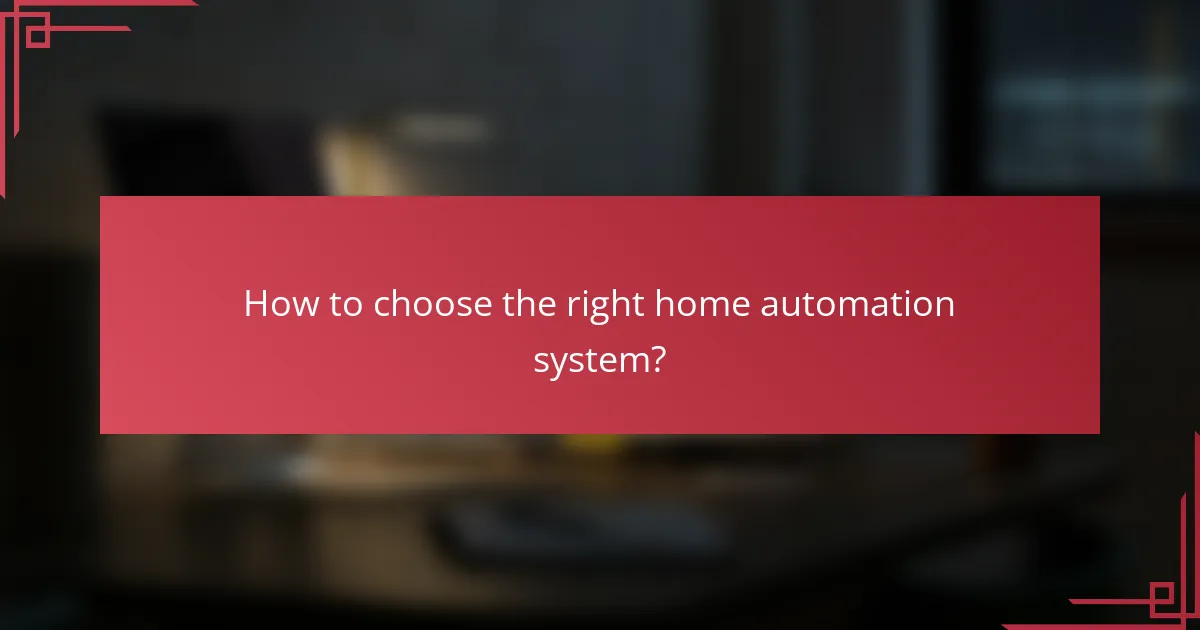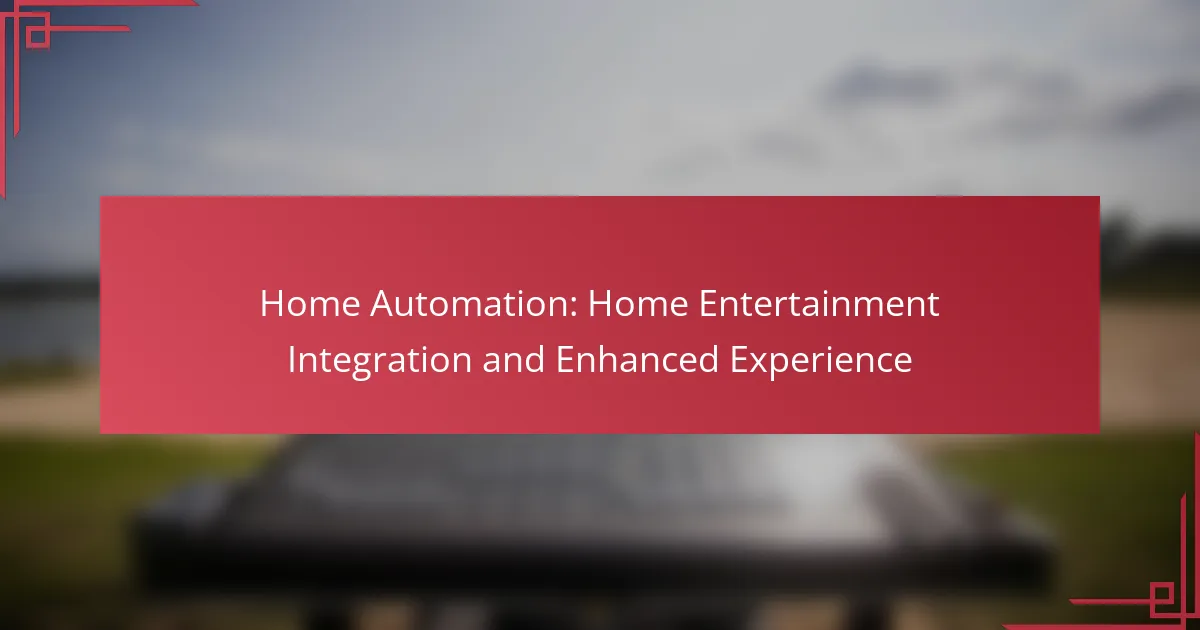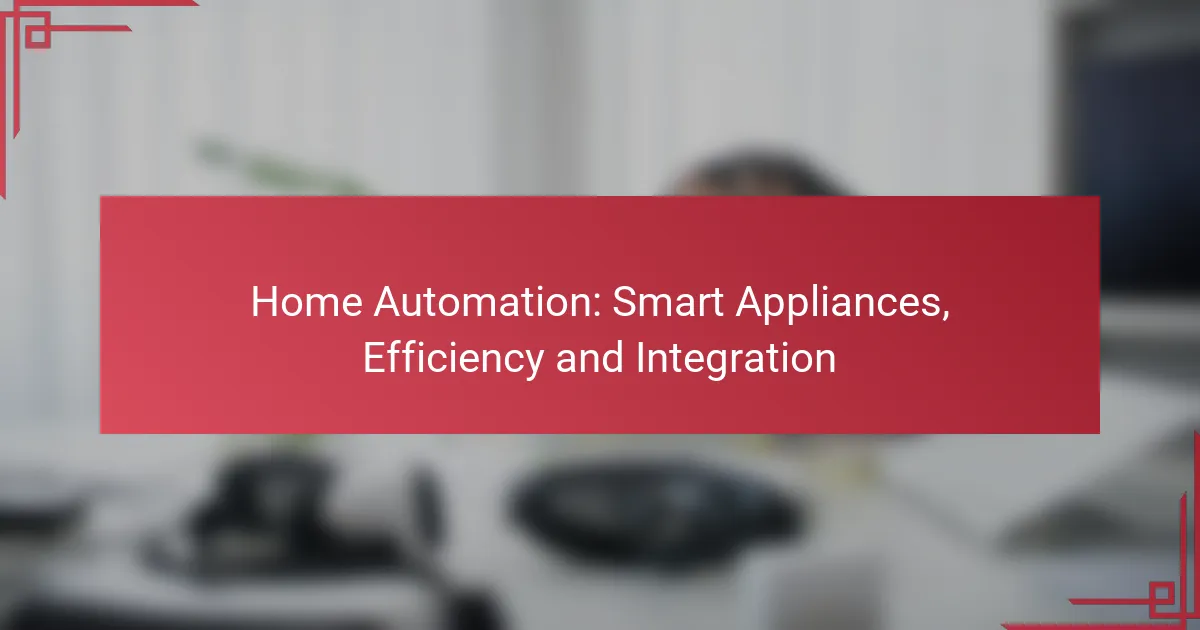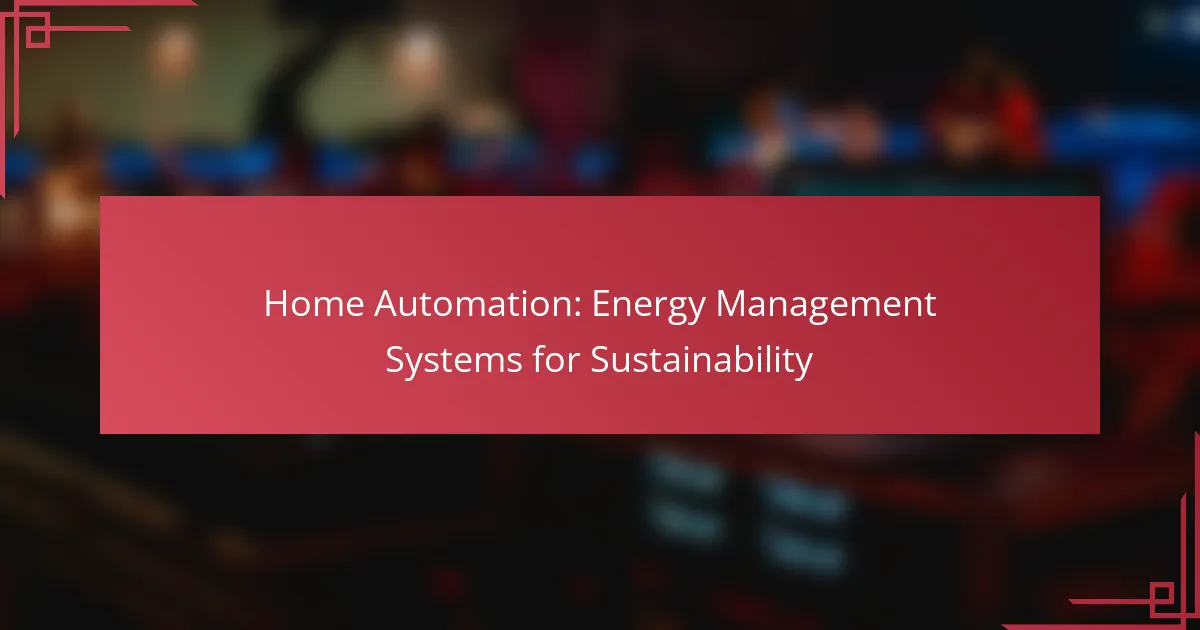Home automation in entertainment transforms your living space into a hub of convenience and enjoyment by integrating smart devices such as TVs, audio systems, and streaming platforms. This seamless connectivity allows users to control multiple systems from a single interface, enhancing accessibility and functionality for an enriched viewing experience. With essential devices like smart speakers and universal remotes, you can effortlessly manage your media and elevate your home entertainment to new heights.

How can I integrate home entertainment systems in Dublin?
Integrating home entertainment systems in Dublin involves connecting various devices to create a seamless experience. This can include smart TVs, audio systems, streaming devices, and voice control systems, all tailored to your preferences and local availability.
Smart TV integration
Smart TV integration allows you to connect your television to the internet and other devices, enabling access to streaming services, apps, and smart home features. Consider models that support popular platforms like Netflix, Amazon Prime, and local Irish services.
Ensure your smart TV is compatible with your home network, ideally using Wi-Fi or Ethernet for stable connections. Look for features like screen mirroring and HDMI-CEC for easier control of connected devices.
Multi-room audio systems
Multi-room audio systems let you play music throughout your home, creating a cohesive sound experience. Systems like Sonos or Bose can be easily integrated into your existing setup, allowing you to control music from your smartphone or tablet.
When choosing a system, consider the layout of your home and the number of rooms you want to include. Wireless options are convenient, but ensure they have good range and minimal latency to avoid sync issues.
Streaming device compatibility
Streaming devices such as Roku, Chromecast, or Apple TV enhance your entertainment options by providing access to various streaming services. Ensure that your chosen device is compatible with your smart TV and supports the content you want to watch.
Check for features like 4K support and voice control capabilities, which can improve your viewing experience. Additionally, consider the ease of setup and user interface when selecting a streaming device.
Home theater setup options
A home theater setup can elevate your viewing experience with surround sound and larger screens. Consider options like projectors for a cinematic feel or high-quality sound systems from brands like Yamaha or Denon.
When planning your setup, think about room acoustics and seating arrangements to optimize sound and visuals. Budget for necessary equipment, including speakers, receivers, and cables, which can vary widely in price.
Voice control systems
Voice control systems, such as Amazon Alexa or Google Assistant, allow you to manage your home entertainment with simple voice commands. These systems can integrate with smart TVs, audio devices, and streaming services for hands-free operation.
When implementing voice control, ensure that your devices are compatible and consider privacy settings. Voice assistants can also be used to control lighting and other smart home features, enhancing overall convenience.

What are the benefits of home entertainment integration?
Home entertainment integration offers a seamless experience by connecting various devices, enhancing convenience and enjoyment. This integration allows users to control multiple systems from a single interface, improving accessibility and functionality.
Enhanced user experience
Integrating home entertainment systems creates a more immersive and enjoyable experience. For instance, a single remote can manage your TV, sound system, and streaming devices, eliminating the hassle of juggling multiple controls. This streamlined approach allows for smoother transitions between activities, like watching movies or listening to music.
Additionally, smart home systems can automate settings based on user preferences, such as dimming lights or adjusting sound levels when starting a movie. This personalization enhances the overall enjoyment of your entertainment setup.
Centralized control
Centralized control simplifies the management of various entertainment devices. With a smart hub or app, users can operate TVs, speakers, and streaming devices from one location, reducing clutter and confusion. This setup often includes voice control options, making it even easier to switch between tasks.
Moreover, centralized control can integrate with other smart home features, such as security systems and lighting, allowing for a cohesive smart home experience. This interconnectedness enhances convenience and efficiency in daily routines.
Increased property value
Home entertainment integration can significantly boost property value by appealing to tech-savvy buyers. A well-designed entertainment system is often seen as a desirable feature, making homes more attractive in the real estate market. Potential buyers appreciate the convenience and modernity that integrated systems provide.
Investing in quality equipment and installation can yield returns when selling a home, as buyers are willing to pay a premium for properties with advanced technology. This trend is particularly relevant in urban areas where smart home features are increasingly sought after.
Energy efficiency
Home entertainment integration can lead to improved energy efficiency through smart technology. Devices can be programmed to turn off when not in use, reducing unnecessary power consumption. For example, a smart power strip can cut power to multiple devices simultaneously, minimizing energy waste.
Additionally, many integrated systems allow users to monitor energy usage, helping identify which devices consume the most power. This awareness can guide decisions on upgrades or replacements, ultimately leading to lower energy bills and a reduced carbon footprint.

What devices are essential for home entertainment automation?
Essential devices for home entertainment automation include smart speakers, streaming devices, smart TVs, and universal remotes. These devices work together to create a seamless and integrated entertainment experience, allowing users to control their media easily and efficiently.
Smart speakers
Smart speakers serve as the central hub for home entertainment automation, enabling voice control for various devices. Popular options like Amazon Echo and Google Nest can play music, control smart TVs, and even manage lighting, enhancing the overall experience.
When choosing a smart speaker, consider compatibility with your existing devices and ecosystems. Look for features like multi-room audio and built-in voice assistants to maximize functionality.
Streaming devices
Streaming devices, such as Roku, Amazon Fire TV, and Apple TV, allow users to access a wide range of content from various platforms. These devices connect to your TV and provide an interface for streaming services like Netflix, Hulu, and Disney+.
When selecting a streaming device, consider factors like supported resolutions (HD, 4K), ease of use, and available apps. Some devices also offer gaming capabilities, which can be an added bonus for entertainment enthusiasts.
Smart TVs
Smart TVs integrate streaming capabilities directly into the television, eliminating the need for additional devices. They come with built-in apps for popular streaming services and often support voice control through smart speakers.
When purchasing a smart TV, pay attention to screen size, resolution, and smart features. Look for models that support the latest standards, such as HDR and Dolby Vision, for an enhanced viewing experience.
Universal remotes
Universal remotes simplify control by allowing users to manage multiple devices with a single remote. They can be programmed to operate TVs, streaming devices, sound systems, and more, reducing clutter and confusion.
When choosing a universal remote, consider compatibility with your devices and ease of programming. Some models offer smart features, such as touch screens and voice control, which can further streamline your entertainment setup.

How to choose the right home automation system?
Choosing the right home automation system involves assessing compatibility with your existing devices, scalability for future upgrades, and the user interface’s ease of use. Prioritize systems that seamlessly integrate with your current technology and offer a straightforward setup and operation.
Compatibility with existing devices
Compatibility is crucial when selecting a home automation system. Ensure that the system can connect with your current devices, such as smart speakers, lights, and security cameras. Look for systems that support popular protocols like Zigbee, Z-Wave, or Wi-Fi to maximize integration options.
Before purchasing, check the manufacturer’s website for a list of compatible devices. This can save you time and money by preventing the need for additional purchases or replacements.
Scalability options
Scalability refers to the ability to expand your home automation system over time. Choose a system that allows you to easily add new devices or features without significant upgrades. This flexibility is essential as technology evolves and your needs change.
Consider systems that offer modular components or cloud-based services, which can be updated with new features as they become available. This approach can help you avoid obsolescence and ensure your system remains current.
User interface and ease of use
The user interface should be intuitive and accessible for all household members. Look for systems that provide a user-friendly app or web interface, allowing you to control devices easily from your smartphone or tablet. Voice control options can also enhance usability.
Before committing, try out the interface if possible. Many retailers offer display models or demos, allowing you to evaluate how easily you can navigate the system and manage your devices.

What are the costs associated with home entertainment integration in Ireland?
The costs of home entertainment integration in Ireland can vary significantly based on the complexity of the system and the components involved. Generally, homeowners should expect to invest in both initial setup costs and ongoing subscription fees to maintain and enhance their entertainment experience.
Initial setup costs
Initial setup costs for home entertainment integration typically range from a few hundred to several thousand euros. This includes expenses for devices such as smart TVs, sound systems, streaming devices, and installation services. For a basic setup, you might spend around €500 to €1,500, while a more advanced system could easily exceed €3,000.
When planning your budget, consider the compatibility of devices and whether professional installation is necessary. DIY installations can save money, but they may require technical knowledge to ensure everything works seamlessly together.
Ongoing subscription fees
Ongoing subscription fees for streaming services and software can add to the overall cost of home entertainment integration. Popular services like Netflix, Amazon Prime Video, and Disney+ typically charge between €8 and €15 per month, depending on the plan you choose.
In addition to streaming services, you may also need to budget for software updates and maintenance of smart home systems, which can vary in cost. Some systems may require annual fees for premium features or cloud storage, so it’s wise to review the terms of each service to avoid unexpected charges.



